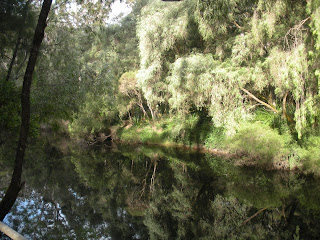Anyway, instead we took a tram ride through the forest, and had a local history lesson from the driver, as well as a description of the trees. But first we passed the timber Mill, reputedly the largest hardwood mill in the southern hemisphere, which processes timber felled from many miles around. Most of the logs are Eucalypts, the many different varieties providing timber for many different uses, from building to decoration, and is exported to countries around the world.

We travelled over six bridges, timber trestles, all built many years ago to serve the original timber industry which relied on the railway to transport the timber to the mill. Nowadays it is all brought in by truck, so some of the track is now used for tourism.
Up to a couple of years ago the trip was much longer, but a drought caused problems with one of the bridges and the tram is now unable to cross it.
This afternoon we travelled the circular route of the Karri Forest Explorer. It is 88kms (56 miles) long and is mainly on gravel roads.
The Karri is a very tall and straight eucalypt tree, which I described yesterday, and which is perfect for logging. Consequently much of the forest was cropped in the early part of the last century, but it has regrown since.
Our tour took us alongside rivers and streams, as well as small lakes, through places of great beauty, up hill and down dale. In three places our path was blocked by fallen trees, as a result of the storms in the past couple of days. We managed to manoeuvre round them fortunately.



Some of the track was very steep, which we had to negotiate in four wheel drive and low gear. The track of course was rather wet, water running down in places, but we travelled slowly to take in the beauty of our surroundings. There are a few bush camps on the trail, which we had a look at, unfortunately we can't take advantage of them while Anne's hand is in the condition it is.

















































